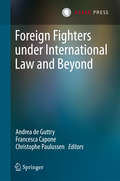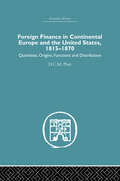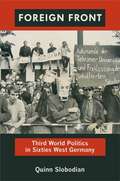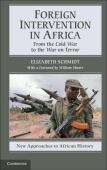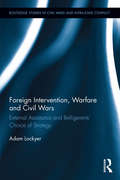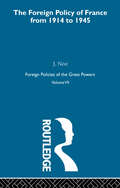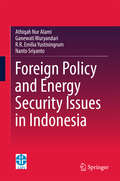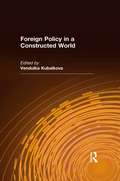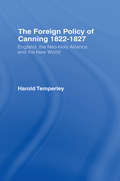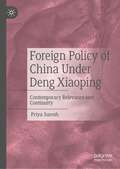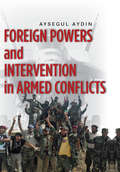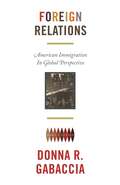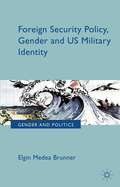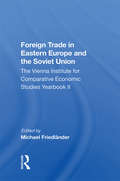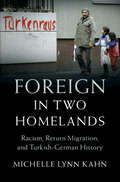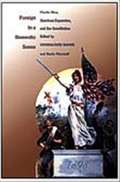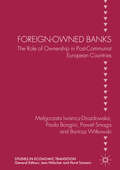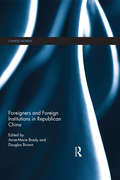- Table View
- List View
Foreign Direct Investments from Emerging Markets
by Karl P. Sauvant Geraldine Mcallister Wolfgang A. MaschekForeign direct investment from emerging markets is an increasingly important phenomenon; firms from developed countries alone no longer undertake this activity. "Foreign Direct Investment from Emerging Markets "provides the latest scholarship on this subject from eminent contributors from around the world. This volume demonstrates the importance of rigorous analysis to understand the dilemmas, the controversies, the disputes, and the policy issues that need to be considered in connection with this new phenomenon. In the wake of the financial crisis, it is more critical than ever for those involved in FDI research and policy to understand these issues. "
Foreign Enterprise in Nigeria: Laws and Policies
by Paul O. ProehlThis study of a newly independent and developing country describes the environment the foreign investor may expect to find if he ventures into Nigeria. The emphasis in on the legal system, but the author also examines certain nonlegal factors, such as the 1962-68 Development Plan, education, and manpower, which all condition the investment climate of the country.Originally published 1965.A UNC Press Enduring Edition -- UNC Press Enduring Editions use the latest in digital technology to make available again books from our distinguished backlist that were previously out of print. These editions are published unaltered from the original, and are presented in affordable paperback formats, bringing readers both historical and cultural value.
Foreign Fighters and Radical Influencers: Radical Milieus in the Postwar Balkans (Political Violence)
by Asya MetodievaThis book looks at Salafi influencers and foreign fighters in the Balkans to examine how the origins and dynamics of radical milieus are related to the legacy of the Bosnian War and the Kosovo War. The work seeks to understand if and in what ways these wars influenced the consolidation of radical milieus and whether they impacted the recruitment of foreign fighters. In doing so, the book traces the path of more than 400 individuals that either traveled to Syria or were involved in recruitment locally. Employing a qualitative methodological approach, the book argues that radical influencers are likely to be more evident in postwar societies due to state and societal fragility, which create more power for social actors and constrain efforts to counter extremism. Through the activism of social actors emerging from wars, preceding conflicts resonate through society across different locations and particular postwar radical milieus do not need to be only in the place where war atrocities happened. Thus, radical milieus can spread to various locations including countries hosting postwar diaspora communities. This book will be of much interest to students of radicalisation, terrorism and political violence, Balkan politics, Middle Eastern politics, and IR in general.
Foreign Fighters under International Law and Beyond
by Christophe Paulussen Andrea De Guttry Francesca CaponeThis book offers various perspectives, with an international legal focus, on an important and underexplored topic, which has recently gained momentum: the issue of foreign fighters. It provides an overview of challenges, pays considerable attention to the status of foreign fighters, and addresses numerous approaches, both at the supranational and national level, on how to tackle this problem. Outstanding experts in the field - lawyers, historians and political scientists - contributed to the present volume, providing the reader with a multitude of views concerning this multifaceted phenomenon. Particular attention is paid to its implications in light of the armed conflicts currently taking place in Syria and Iraq. Andrea de Guttry is a Full Professor of International Law at the Scuola Superiore Sant'Anna, Pisa, Italy. Francesca Capone is a Research Fellow in Public International Law at the Scuola Superiore Sant'Anna. Christophe Paulussen is a Senior Researcher at the T. M. C. Asser Instituut in The Hague, the Netherlands, and a Research Fellow at the International Centre for Counter-Terrorism - The Hague.
Foreign Finance in Continental Europe and the United States 1815-1870: Quantities, Origins, Functions and Distribution
by D.C.M. PlattFirst Published in 2005. Routledge is an imprint of Taylor & Francis, an informa company.
Foreign Front: Third World Politics in Sixties West Germany
by Quinn SlobodianIt is often asserted that West German New Leftists "discovered the Third World" in the pivotal decade of the 1960s. Quinn Slobodian upsets that storyline by beginning with individuals from the Third World themselves: students from Africa, Asia, and Latin America who arrived on West German campuses in large numbers in the early 1960s. They were the first to mobilize German youth in protest against acts of state violence and injustice perpetrated beyond Europe and North America. The activism of the foreign students served as a model for West German students, catalyzing social movements and influencing modes of opposition to the Vietnam War. In turn, the West Germans offered the international students solidarity and safe spaces for their dissident engagements. This collaboration helped the West German students to develop a more nuanced, empathetic understanding of the Third World, not just as a site of suffering, poverty, and violence, but also as the home of politicized individuals with the capacity and will to speak in their own names.
Foreign Intervention in Africa
by Elizabeth SchmidtForeign Intervention in Africa chronicles the foreign political and military interventions in Africa from 1956 to 2010, during the periods of decolonisation and the Cold War, as well as during the periods of state collapse and the 'global war on terror'. In the first two periods, the most significant intervention was extra-continental. The USA, the Soviet Union, China, Cuba and the former colonial powers entangled themselves in countless African conflicts. During the period of state collapse, the most consequential interventions were intra-continental. African governments, sometimes assisted by powers outside the continent, supported warlords, dictators and dissident movements in neighbouring countries and fought for control of their neighbours' resources. The global war on terror, like the Cold War, increased foreign military presence on the African continent and generated external support for repressive governments. In each of these cases, external interests altered the dynamics of Africa's internal struggles, escalating local conflicts into larger conflagrations, with devastating effects on African peoples.
Foreign Intervention, Warfare and Civil Wars: External Assistance and Belligerents' Choice of Strategy (Routledge Studies in Civil Wars and Intra-State Conflict)
by Adam LockyerThis book examines the impact of foreign intervention in the course and nature of warfare in civil wars. Throughout history, foreign intervention in civil wars has been the rule rather than the exception. The involvement of outside powers can have a dramatic impact on the course and nature of internal conflicts. Despite this, there has been little research which has sought to explain how foreign intervention influences the course of civil wars. This book seeks to rectify this gap. It examines the impact of foreign intervention on the warfare that characterises civil wars through by studying the cases of the Angolan and Afghan civil wars. It investigates how foreign resources affect the military power of the recipient belligerent, and examines how changes in the balance of capabilities influence the form of warfare that characterises a civil war. Warfare in civil wars is often highly fluid, with belligerents adapting their respective strategies in response to shifts in the balance of military capabilities. This book shows how the intervention of foreign powers can manipulate the balance of capabilities between the civil war belligerents and change the dominant form of warfare. The findings presented in this book offer key insights for policy-makers to navigate the increasing internationalization of civil wars around the globe. This book will be of much interest to students of civil wars, intra-state conflict, war and conflict studies, and security studies.
Foreign Jack Tars: The British Navy and Transnational Seafarers during the Revolutionary and Napoleonic Wars (Modern British Histories)
by Sara CaputoThe British Royal Navy of the French Wars (1793–1815) is an enduring national symbol, but we often overlook the tens of thousands of foreign seamen who contributed to its operations. Foreign Jack Tars presents the first in-depth study of their employment in the Navy during this crucial period. Based on sources from across Britain, Europe, and the US, and blending quantitative, social, cultural, economic, and legal history, it challenges the very notions of 'Britishness' and 'foreignness'. The need for manpower during wartime meant that naval recruitment regularly bypassed cultural prejudice, and even legal status. Temporarily outstripped by practical considerations, these categories thus revealed their artificiality. The Navy was not simply an employer in the British maritime market, but a nodal point of global mobility. Exposing the inescapable transnational dimensions of a quintessentially national institution, the book highlights the instability of national boundaries, and the compromises and contradictions underlying the power of modern states.
Foreign Missions of an American Prosecutor: From Moscow to Morocco and Paris to the Persian Gulf
by John HailmanIn his fifth book, John Hailman recounts the adventures and misadventures he experienced during a lifetime of international travel. From Oman to Indonesia, from sandstorms and food poisoning to gangsters and at least one jealous husband, Hailman explores the cultures and court systems of faraway countries. The international story begins in Paris as a young Hailman, a student at La Sorbonne, experiences the romance and excitement one expects from the City of Lights. Years later Hailman returns to France, to Interpol Headquarters in Lyon where he received his international law certificate from the National School for Magistrates. Traveling the world as a representative for the US Justice Department, Hailman encountered criminals and conspiracies, including a plot in Ossetia, Georgia, to hijack his helicopter and kidnap him. From his time as a prosecutor are tales of three very different Islamic cultures in the colorful societies and legal systems of Tunisia, Algeria, and Morocco. Hailman also travels to the chaotic world of the former Soviet Union where, at the time of his visit, a new world of old countries was trying to rediscover independent pasts. He explores the tiny country of Moldova and the beautiful and picturesque Republic of Georgia, and visits Russia during the brief period democracy was flowering and the nation was experimenting with a new jury trial system. Viewing his adventures through the lens of laws and customs, Hailman is able to give unique insight to the countries he visits. With each new adventure in Foreign Missions of an American Prosecutor, John Hailman shares his passion for travel and his fascination with other cultures.
Foreign Modernism
by Ihor JunykAt the beginning of the twentieth century, Paris was the cosmopolitan hub of Europe and home to a vast number of foreigners - including the writers, painters, sculptors, and musicians who were creating works now synonymous with modernism itself, such as Les Desmoiselles d'Avignon, The Rite of Spring, and Ulysses. The situation at the end of the period, however, could not have been more different: even before the violence of the Second World War, the cosmopolitan avant-garde had largely abandoned Paris, driven out by nationalism, xenophobia, and intolerance.Foreign Modernism investigates this tense and transitional moment for both modernism and European multiculturalism by looking at the role of foreigners in Paris's artistic scene. Examining works of literature, sculpture, ballet and performing arts, music, and architecture, Ihor Junyk combines cultural history with contemporary work in transnationalism and diaspora studies. Junyk emphasizes how émigré artists used radical new forms of art to resist the culture of virulent nationalism taking root in France, and to articulate new forms of cosmopolitan identity.
Foreign Planes in the Service of the Luftwaffe
by Jean-Louis RobaThis pictorial history shows the full extent of captured foreign aircraft used by Nazi Germany during WWII. No air force in the Second World War would make more use of captured planes than the Luftwaffe. With this in mind, military historian Jean-Louis Roba has tracked down hundreds of such aircraft with rare images that illustrate their uses, careers, and eventual fates. Foreign Planes in the Service of the Luftwaffe covers the complete history of this practice from its inception in the prewar years to the end of the Second World War. Roba&’s significant research on the topic debunks myths about how prepared for war the Germans were in 1939. This volume demonstrates how important captured planes—a decidedly unreliable resource—would become to the Luftwaffe. Translated into English for the first time, Roba&’s investigative work is supported by more than a hundred pictures of the planes themselves, and gives a rare opportunity to see British and American planes repainted in German colors and symbols.
Foreign Pol France 1914-45 V7
by NereFirst published in 2001. Routledge is an imprint of Taylor & Francis, an informa company.
Foreign Policy and Energy Security Issues in Indonesia
by Athiqah Nur Alami Ganewati Wuryandari R.R. Emilia Yustiningrum Nanto SriyantoThis book examines energy security as one of nontraditional issues that are strategic for Indonesia's foreign policy. It argues that energy has not been considered as a strategic commodity in the foreign policy to support the effectiveness of Indonesia's diplomacy at the regional and international levels. International and outward looking perspectives have not been much visible both in the policy and political realities. Since foreign policy is a reflection of domestic politics under the influence of international developments, this study focuses its analysis on the domestic and international aspects of the energy security issues.
Foreign Policy in a Constructed World
by Vendulka KubalkovaThis volume demonstrates the application of the constructivist approach to the analysis of foreign policy (i.e. states' actions in a world of states). Part I introduce constructivism for foreign policy studies. Part II presents five model case studies -- the Cold War, Francoism, the two Chinas, inter-American relations, and Islam in U.S. foreign policy. Part III reviews their results.
Foreign Policy of China Under Deng Xiaoping: Contemporary Relevance and Continuity
by Priya SureshThe book examines, linking two key variables – ‘political leadership’ and ‘foreign policy’ – the role of Deng Xiaoping in China’s foreign policy shift after Mao in politico-strategic and economic domains. The book finds out that guided by his own personality, worldview, experience, pragmatism, belief and style Deng attempted to resolve the long-standing domestic and foreign policy issues. Most importantly, Deng moved from the primacy of politics to economic modernisation which resulted in far-reaching changes in China’s external engagement. The book's central inquiry is to assess the contemporary relevance of Deng’s foreign policy paradigm. It establishes that the relevance of Deng’s policy continues in the present context except for China’s pro-activeness towards issues pertaining to its territorial integrity and sovereignty. Using China’s case, the study advances the framework of understanding pertaining to the role of political leadership in foreign policy.
Foreign Powers and Intervention in Armed Conflicts
by Aysegul AydinIntervention in armed conflicts is full of riddles that await attention from scholars and policymakers. This book argues that rethinking intervention-redefining what it is and why foreign powers take an interest in others' conflicts-is of critical importance to understanding how conflicts evolve over time with the entry and exit of external actors. It does this by building a new model of intervention that crosses the traditional boundaries between economics, international relations theory, and security studies, and places the economic interests and domestic political institutions of external states at the center of intervention decisions. Combining quantitative and qualitative evidence from both historical and contemporary conflicts, including interventions in both interstate conflicts and civil wars, it presents an in-depth discussion of a range of interventions-diplomatic, economic, and military-in a variety of international contexts, creating a comprehensive model for future research on the topic.
Foreign Relations: American Immigration in Global Perspective (America in the World #19)
by Donna R. GabacciaA new history exploring U.S. immigration in global contextHistories investigating U.S. immigration have often portrayed America as a domestic melting pot, merging together those who arrive on its shores. Yet this is not a truly accurate depiction of the nation's complex connections to immigration. Offering a brand-new global history of the subject, Foreign Relations takes a comprehensive look at the links between American immigration and U.S. foreign relations. Donna Gabaccia examines America’s relationship to immigration and its debates through the prism of the nation’s changing foreign policy over the past two centuries. She shows that immigrants were not isolationists who cut ties to their countries of origin or their families. Instead, their relations to America were often in flux and dependent on government policies of the time.An innovative history of U.S. immigration, Foreign Relations casts a fresh eye on a compelling and controversial topic.
Foreign Security Policy, Gender, and US Military Identity
by Elgin Medea BrunnerThe concept of 'othering' which can be understood as the process of differentiation from the Self has been a basic tenet of the war story since war stories were first told. This practise of deliberate differentiation is indicative of the fact that war stories are essentially about the production of identity. The aim of this book, therefore, is to unravel some of the gendered ideologies that underpin the link between state identity and foreign security policy by looking at a certain case, state and foreign security policy. In particular this volume explores the identity of the United States through military documents on perception management in conflict from 1991-2007 shedding light on the 'othering' and the 'selfing' that occurs in these particular war stories. In doing so it lays bare the gendered ideologies that underpins US identity between these years as well as exploring potential spaces for alternatives. Thus, this book ventures a detailed and unique look at a particular aspect of the gendered reproduction of the state.
Foreign Trade In Eastern Europe And The Soviet Union: The Vienna Institute For Comparative Economic Studies Yearbook Ii
by Michael FriedländerThis second yearbook of The Vienna Institute for Comparative Economic Studies presents studies dealing with the economic situation in Eastern Europe and the Soviet Union. Its foreign trade analysis offers insights into the ongoing transition process from centrally planned to market-oriented systems.
Foreign in Two Homelands: Racism, Return Migration, and Turkish-German History (Publications of the German Historical Institute)
by Michelle Lynn KahnWhat happens when migrants are rejected by the host society that first invited them? How do they return to a homeland that considers them outsiders? Foreign in Two Homelands explores the transnational history of Turkish migrants, Germany's largest ethnic minority, who arrived as 'guest-workers' (Gastarbeiter) between 1961 and 1973. By the 1980s, amid rising racism, neo-Nazis and ordinary Germans blamed Turks for unemployment, criticized their Muslim faith, and argued they could never integrate. In 1983, policymakers enacted a controversial law: paying Turks to leave. Thus commenced one of modern Europe's largest and fastest waves of remigration: within one year, 15% of the migrants—250,000 men, women, and children—returned to Turkey. Their homeland, however, ostracized them as culturally estranged 'Germanized Turks' (Almancı). Through archival research and oral history interviews in both countries and languages, Michelle Lynn Kahn highlights migrants' personal stories and reveals how many felt foreign in two homelands. This title is also available as Open Access on Cambridge Core.
Foreign in a Domestic Sense: Puerto Rico, American Expansion, and the Constitution
by Christina Duffy Burnett Burke MarshallIn this groundbreaking study of American imperialism, leading legal scholars address the problem of the U. S. territories. Foreign in a Domestic Sense will redefine the boundaries of constitutional scholarship. More than four million U. S. citizens currently live in five "unincorporated" U. S. territories. The inhabitants of these vestiges of an American empire are denied full representation in Congress and cannot vote in presidential elections. Focusing on Puerto Rico, the largest and most populous of the territories, Foreign in a Domestic Sense sheds much-needed light on the United States' unfinished colonial experiment and its legacy of racially rooted imperialism, while insisting on the centrality of these "marginal" regions in any serious treatment of American constitutional history. For one hundred years, Puerto Ricans have struggled to define their place in a nation that neither wants them nor wants to let them go. They are caught in a debate too politicized to yield meaningful answers. Meanwhile, doubts concerning the constitutionality of keeping colonies have languished on the margins of mainstream scholarship, overlooked by scholars outside the island and ignored by the nation at large. This book does more than simply fill a glaring omission in the study of race, cultural identity, and the Constitution; it also makes a crucial contribution to the study of American federalism, serves as a foundation for substantive debate on Puerto Rico's status, and meets an urgent need for dialogue on territorial status between the mainlandd and the territories. Contributors. Jos Julin lvarez Gonzlez, Roberto Aponte Toro, Christina Duffy Burnett, Jos A. Cabranes, Sanford Levinson, Burke Marshall, Gerald L. Neuman, Angel R. Oquendo, Juan Perea, Efrn Rivera Ramos, Rogers M. Smith, E. Robert Statham Jr. , Brook Thomas, Richard Thornburgh, Juan R. Torruella, Jos Tras Monge, Mark Tushnet, Mark Weiner
Foreign-Owned Banks: The Role Of Ownership In Post-communist European Countries (Studies In Economic Transition Ser.)
by Małgorzata Iwanicz-Drozdowska Paola Bongini Paweł Smaga Bartosz WitkowskiThis book provides an in-depth analysis of the role of foreign-owned banks for credit growth, financial stability and economic growth in the post-communist European countries. Using data covering 20 countries over the period from 1995 to 2015, the authors analyse the evolution of banking sectors in CESEE after the transformation in the historical context. This helps draw a new picture of the role of financial development and EU accession in that region, being also a lesson for other countries or regions in transition. Additionally, as the Global Financial Crisis has left a stigma in banking sectors, the book shows its impact on the post-communist banking sectors. As the foreign banks dominate the banking sectors in CESEE countries (the stake of foreign-owned banks is below 50% of assets in only five out of 20 countries), their strategies materially impact the development of CESEE banking sectors, which warrants our scientific exploration.Arriving at a clear concluding point of view on the role of foreign-owned banks and providing insights for future policy of CESEEs towards foreign presence in their banking sectors, this book should be of interest to academics, students, and policymakers.
Foreigners and Foreign Institutions in Republican China (Chinese Worlds)
by Douglas Brown Anne-Marie BradyRepublican China attracted an uncommon diversity of foreign interests, groups, and individuals, which included missionaries, adventurers, diplomats, academics, humanitarians and refugees, as well as hedonists and tourists. By exploring the diverse nature of foreign activities in Republican China, this book complicates the dominant narratives of the imperialistic foreigner and Chinese victim, and moves beyond the depiction of foreigners as privileged and the Chinese as simply weak. The spaces and relationships examined in the essays in this volume reveal a complex series of interactions between foreigners and the people of China which go far beyond one-way transmission or exploitation. Indeed, this book examines how diverse and sometimes seemingly peripheral foreign individuals and communities influenced literature, education, trade, sexual morality, warfare, and architecture in China and in the process were themselves profoundly changed, in ways that are as remarkable as those experienced by the Chinese they had come to observe, meet, exploit, conquer, assist, or change. Bringing together the work of a diverse group of scholars on Republican China, this edited volume adopts a uniquely multi-disciplinary approach to the study of foreigners in China, and utilises the perspectives of historiography, literary studies, cultural studies, sociology, anthropology, and political science. As such, this interesting and innovative book will be of great interest to students and scholars from diverse fields including Chinese and global history, politics and international relations, Chinese studies, literary studies and gender studies.



